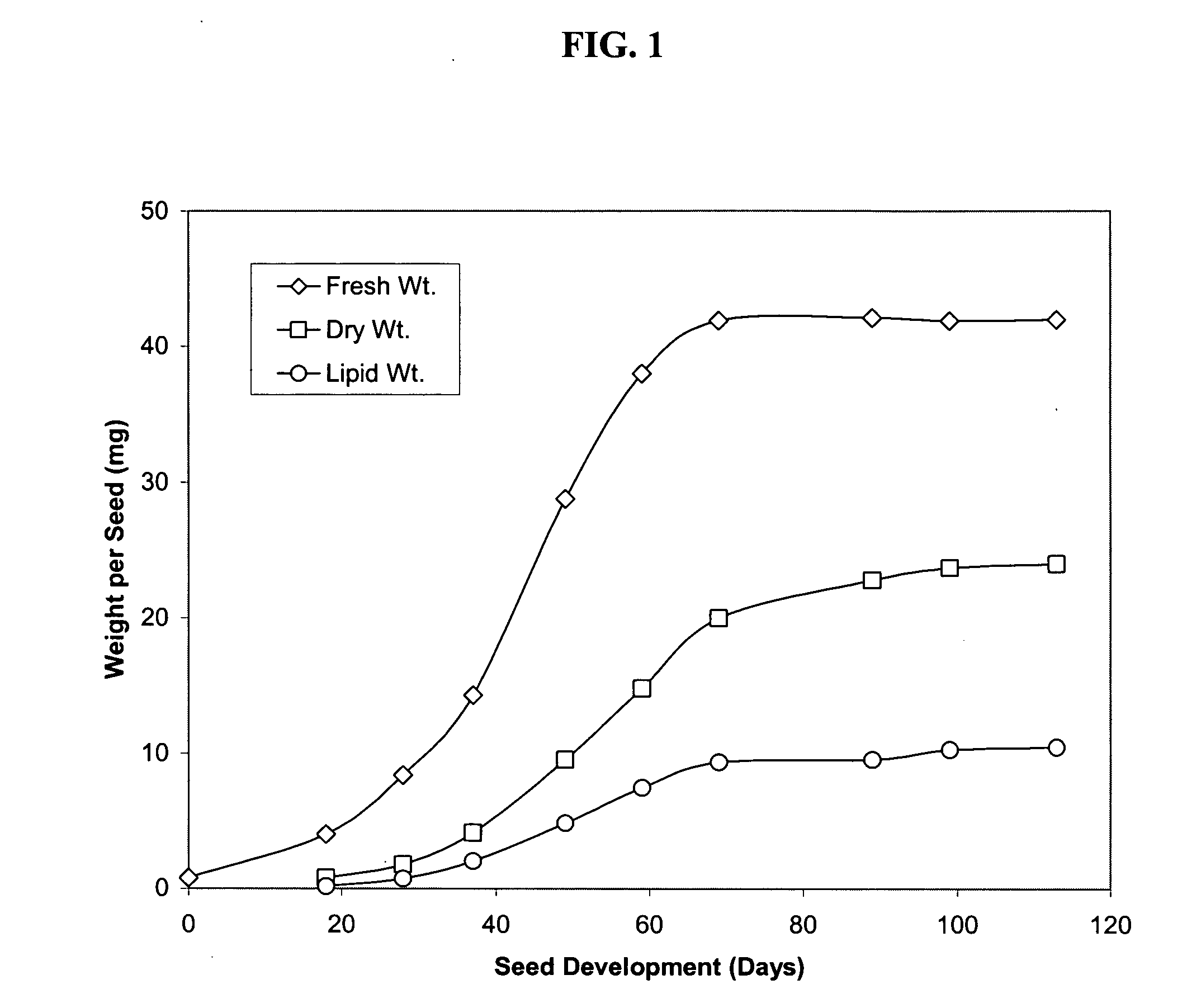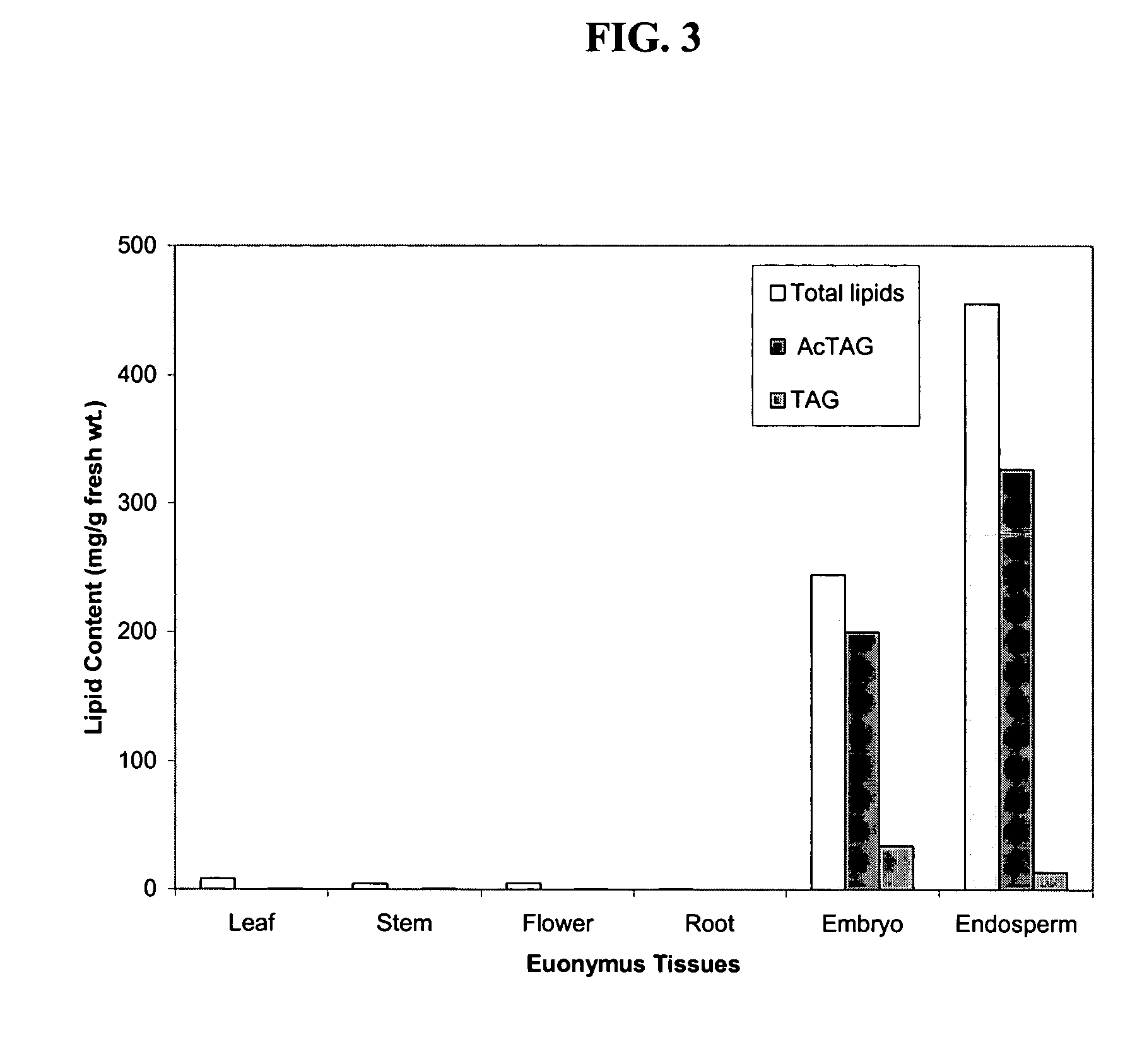Diacylglycerol acyltransferase genes, proteins, and uses thereof
a technology of diacylglycerol acetyltransferase and diacylglycerol, which is applied in the direction of transferases, enzymology, organic chemistry, etc., can solve the problems of not being able to grow commercially plants and no commercial sources of oils rich in sn-3-acetyl glycerides
- Summary
- Abstract
- Description
- Claims
- Application Information
AI Technical Summary
Benefits of technology
Problems solved by technology
Method used
Image
Examples
example 1
Experimental Plant Biochemistry Procedures
A. Materials
[0301] Developing Seeds
[0302]Euonymus alata developing seeds were collected from bushes on the Michigan State University campus, courtesy of the WJ Beal Garden and Campus Woody Plants. Seed capsules were harvested from mid-August through November. Seeds were removed from the capsule and from their yellowish-orange pericarp. Some fresh seeds were halved and used immediately for in vivo labeling experiments. For other seeds, the seed coats were removed and the cotyledons and embryos were either immediately used for the preparation of enzyme extracts or frozen in liquid nitrogen and stored at −80° C. for subsequent RNA extraction, for the preparation of cell free extracts for enzymology, or for lipids analysis.
[0303] RadioChemicals
[0304] [1-14C]Acetate was purchased from American Radiolabeled Chemicals, Inc., while [1-14C]acetyl-CoA, [1-14C]palmitoyl-CoA and [1-14C]oleoyl-CoA were purchased from New England Nuclear. Specific a...
example 2
Euonymus Biochemistry
A. Endogenous Lipids and Seed Development
[0312] Flowering of Euonymus alata occurs in late May, but the onset of the seed maturation phase is delayed until August. During maturation the seed coat bracts become colored intensely orange. Seed fresh weight, dry weight and lipid accumulation over time is shown in FIG. 1. These accumulations follow a pattern typical for developing oilseeds. The oil content of the seed at maturity was 43%. Most of the lipid deposition occurred in September and during this period approximately 0.24 mg lipid / day / seed was deposited. Since this lipid is mainly 3-acetyl-1,2-diacyl-sn-glycerol (MW of 1,2-dioleoyl-3-acetyl-sn-glycerol is 662), and since at mid-maturation the average seed fresh weight is about 30 mg, this gives an average rate of 3-acetyl-1,2-diacyl-sn-glycerol deposition of approximately 500 nmoles / hr / gfw. This rate of deposition is a useful specific activity against which to judge the degree of contribution of exogenous ...
example 3
[0330] DAGAT Cloning
[0331] A Euonymus cDNA for DAGAT was obtained via RT-PCR using degenerated primers and subsequently 3′ and 5′ RACE to define the 3′ and 5′ cDNA ends. A full length cDNA clone was obtained via RT-PCR using primers based on the sequence of the 3′ and 5′ RACE products.
A. General Methods
[0332] Total RNA from developing Euonymus seeds was extracted according to the procedures of Schultz et al. (1994) (Plant Mol. Biol. Rep. 12: 310-316) or Chung et al. (1996) (Mol. Cells 6: 108-111). For all PCR reactions described below, appropriate controls were included, consisting of the PCR reaction with each primer only. Escherichia coli strain HB101 was grown at 37° C. in Luria Broth media (Silhavy et al, 1984), supplemented with the appropriate antibiotics for selection of the constructs: ampicillin 100 mg / ml (pYES2CT), kanamycin 50 mg / ml (pE1776), rifampicine 50 mg / ml (pBBPhas). Database searches were done using the BLAST algorithm. DNA sequences and the deduced amino acid...
PUM
| Property | Measurement | Unit |
|---|---|---|
| Length | aaaaa | aaaaa |
| Nucleic acid sequence | aaaaa | aaaaa |
Abstract
Description
Claims
Application Information
 Login to View More
Login to View More - R&D
- Intellectual Property
- Life Sciences
- Materials
- Tech Scout
- Unparalleled Data Quality
- Higher Quality Content
- 60% Fewer Hallucinations
Browse by: Latest US Patents, China's latest patents, Technical Efficacy Thesaurus, Application Domain, Technology Topic, Popular Technical Reports.
© 2025 PatSnap. All rights reserved.Legal|Privacy policy|Modern Slavery Act Transparency Statement|Sitemap|About US| Contact US: help@patsnap.com



